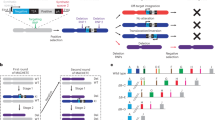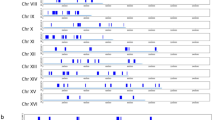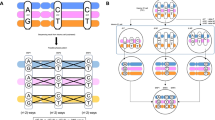Abstract
THE molecular analysis of many genetic diseases requires the isolation of probes for defined human chromosome regions. Existing techniques such as the screening of chromosome-specific libraries1, subtractive DNA cloning2 and chromosome jumping3 are either tedious or not generally applicable. Microdissection and microcloning has successfully been applied to various chromosome regions in Drosophila and mouse4–9, but conventional microtechniques are too coarse and inefficient for analysis of the human genome10–12. Because microdissection has previously been used on unhanded chromosomes only, cell lines in which the chromosome of interest could be identified without banding had to be used. At least one hundred chromosomes were needed for dissection and λ vectors used to achieve maximum cloning efficiency. Recombinant phage clones are, however, more difficult to characterize than plasmid clones. Here we describe the dissection of the Langer-Giedion syndrome region on chromosome 8 from GTG-banded metaphase chromosomes (G-banding with trypsin-Giemsa) and the universal enzymatic amplification of the dissected DNA. Eighty per cent of clones from this library (total yield 20,000) identify single-copy DNA sequences. Fifty per cent of clones detect deletions in two patients with Langer–Giedion syndrome. Although the other clones have not yet been mapped, this result demonstrates that thousands of region-specific probes can be isolated within ten days.
This is a preview of subscription content, access via your institution
Access options
Subscribe to this journal
Receive 51 print issues and online access
$199.00 per year
only $3.90 per issue
Buy this article
- Purchase on Springer Link
- Instant access to full article PDF
Prices may be subject to local taxes which are calculated during checkout
Similar content being viewed by others
References
Perlman, J. & Fuscoe, J. C. Cytogenet. Cell. Genet. 43, 87–96 (1986).
Kunkel, L. M., Monaco, A. P., Middlesworth, W., Ochs, H. D. & Latt, S. A. Proc. natn. Acad. Sci. U.S.A. 82, 4778–4782 (1985).
Poustka, A., Pohl, T. M., Barlow, D. P., Frischauf, A. M. & Lehrach, H. Nature 325, 353–355 (1987).
Scalenghe, F., Tusco, E., Edström, J.-E., Pirrotta, V. & Melli, M. L. Chromosoma 82, 205–216 (1981).
Röhme, D. et al. Cell 36, 783–788 (1984).
Fisher, E. M. C., Cavanna, J. S. & Brown, S. D. M. Proc. natn. Acad. Sci. U.S.A. 82, 5846–5849 (1985).
Weith, A., Winking, H., Brackmann, B., Boldyreff, B. & Traut, W. EMBO J. 6, 1295–1300 (1987).
Greenfield, A. J. & Brown, S. D. M. Genomics 1, 153–158 (1987).
Edström, J.-E., Kaiser, R. & Röhme, D. in Meth. Enzym. 151, 503–516 (1987).
Bates, G. P., Wainwright, B. J., Williamson, R. & Brown, S. D. M. Molec. cell. Biol. 6, 3826–3830 (1986).
Kaiser, R. et al. Molec. biol. Reports 12, 3–6 (1987).
Kao F.-T. Somatic Cell molec. Genet 13, 375–380 (1987).
Bühler, E. M. & Malik, N. J. Am. J. med. Genet. 19, 113–119 (1984).
Bühler, E. M., Bühler, U. K., Beutler, C. & Fessler, R. A. Clin. Genet. 31, 273–275 (1987).
McKusick, V. A. Mendelian Inheritance in Man (Johns Hopkins University Press, Baltimore, 1988).
Saiki, R. K. et al. Science 230, 1350–1354 (1985).
Bishop, D. T., Williamson, J. A. & Skolnick, M. H. Am. J. hum. Genet. 35, 795–815 (1983).
Zabel, B. U. & Baumann, W. A. Am. J. med. Genet. 11, 353–358 (1982).
Pfeiffer, R. A. Clin. Genet 18, 142–146 (1980).
Harnden, D. G. & Klinger, H. P. (eds) International System for Human Cytogenetic Nomenclature (Karger, Basel, 1985).
Claussen, U., Klein, R. & Schmidt, M. Prenatal Diagnosis 6, 401–408 (1986).
Pfeiffer, B. H. & Zimmermann, S. B. Nucleic Acids Res. 11, 7853–7871 (1983).
Sanger, F., Nicklen, S. & Coulsen, A. R. Proc. natn. Acad. Scl. U.S.A. 74, 5463–5467 (1977).
Horsthemke, B., Greger, V., Barnert, H. J., Höpping, W. & Passarge, E. Hum. Genet. 76, 257–261 (1987).
Lüdecke, H.-J. et al. Hum. Genet (in the press).
Author information
Authors and Affiliations
Rights and permissions
About this article
Cite this article
Lüdecke, HJ., Senger, G., Claussen, U. et al. Cloning defined regions of the human genome by microdissection of banded chromosomes and enzymatic amplification. Nature 338, 348–350 (1989). https://doi.org/10.1038/338348a0
Received:
Accepted:
Issue Date:
DOI: https://doi.org/10.1038/338348a0
This article is cited by
-
Microdissection of the Ah01 chromosome in upland cotton and microcloning of resistance gene anologs from the single chromosome
Hereditas (2017)
-
The inheritance of epigenetic defects
medizinische genetik (2017)
-
Microdissection and painting of the Y chromosome in spinach (Spinacia oleracea)
Journal of Plant Research (2013)
-
Microdissection and Microcloning of Chromosome 5 in Gossypium arboreum
Plant Molecular Biology Reporter (2012)
Comments
By submitting a comment you agree to abide by our Terms and Community Guidelines. If you find something abusive or that does not comply with our terms or guidelines please flag it as inappropriate.



